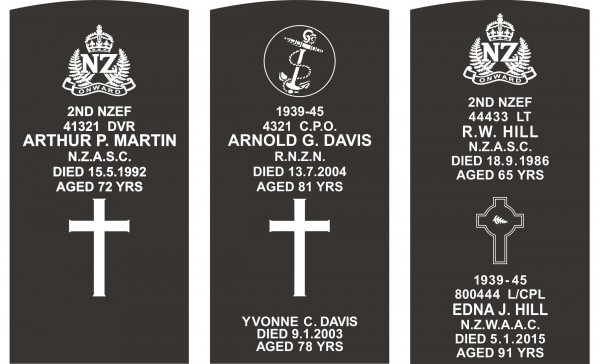Looking after plaques and headstones
It's important to know how to care for your loved one's plaque or headstone.
Public cemeteries are maintained to a high standard by their local authority. This maintenance includes mowing lawns and ensuring general upkeep.
People often want to commemorate their loved ones by caring for their plaques or headstone. Plaques and headstones are made from different materials, and each type needs to be cared for in a certain way.
The type of plaque or headstone used depends on the cemetery.
Plaques
Bronze plaques
The bronze plaque is the most widely used. It measures 37 x 22cm and is made as a single plaque for the veteran only, or a single plaque for both the veteran and their spouse or partner.

Granite plaques
Granite plaques are rectangular (36 x 22cm) for burial plots and square (26 x 22cm) for cremation plots. They're used only in the Rotorua Services Cemetery. This is due to the corrosive nature of the air. Outside Rotorua, bronze plaques are used.

Headstones
The granite headstone measures 76 x 38 x 7.5cm and contains the same information as a plaque but in a slightly different layout.

Granite
Granite is an attractive and durable material that needs very little maintenance. The polished surface has been ground until a natural polish is obtained.
You can keep the granite clean and polished with occasional washing.
- Use clean water to remove any film or dirt from the memorial.
- Wipe the granite dry with a clean cloth.
If moss is growing on the rough rocky edges of an upright headstone, you can clean it off by using a stiff brush and water. A moss retardant can be added to the water.
The use of normal, mild household cleaners will not damage the granite but may cause painted letters to wear more rapidly.
Bronze
Bronze plaques are manufactured with a professional finish. After years of exposure to the elements, it will be naturally replaced with a finish called patina.
Patina isn't a film of colour on the surface, but part of the bronze itself. The colour change of the bronze occurs gradually until the colour becomes stable. The time it takes can vary greatly but usually takes up to 70 to 80 years. It all depends on local atmospheric, weather and soil conditions.
Caring for bronze plaques
Bronze plaques don't require special care to bring about the natural ageing process. However, to reduce staining make sure artificial flowers and other objects are not left on the plaque.
You might prefer to delay the onset of this natural finish. If so, we recommended you:
- wash the plaque with detergent and warm water,
- coat the plaque with a thin film of car or floor polish with a soft brush
- buff the polish back.
Take care to avoid a build-up of polish around the lettering and edges. It is best to apply the wax on a warm day and not more than every three months.
Services Cemeteries and plaques and headstones
- Services Cemeteries
- Burial in a Services Cemetery
- Find a Services Cemetery
- Plaque and headstone funding
- Looking after plaques and headstones
